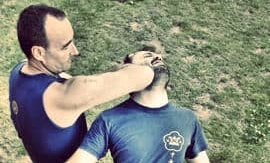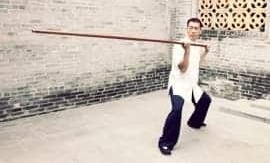
THE TERM GUNG LIK IS OFTEN USED AND BANDED ABOUT BY MANY WING CHUN PRACTITIONERS, BUT WHAT EXACTLY IS MEANT BY GUNG LIK?
Gung Lik is not specifically a martial arts term; it is a generic term, which refers to the energy, skill or achievement that develops and is acquired over a long period of hard work, effort, practice and of course perseverance.
In essence, Gung Lik is the ability to make a complex set of movements or body mechanics look almost effortless! For instance, when you see a top chef chopping up vegetables, they manage to cut the vegetables into equal slices quickly, easily and without cutting themselves—often without even looking!
In Wing Chun, the first section of Siu Nim Tau is referred to as Gung Lik because by practising the movements slowly, seriously, correctly and regularly over a long period of time the movements and structures become effortless, despite the complexity of the body mechanics that are involved.
The first section focuses on the fundamental aspects of the form including relaxation, elbow positioning and also energy, posture, structure and breathing. In order to develop, feel and understand the correct structural shapes of the movements, including the individual muscle groups being used plus gaining an appreciation of the stopping points on extension and retraction, the movements must be done quite slowly, relaxed and regularly—ideally on a daily basis for a minimum of 15 to 20 minutes.
It is important not to tense the muscles or force the arms into the desired positions, such as Fook Sau, as this will result in unnecessary muscular tension and subsequently resistance, plus possibly a distortion of the body posture.
The correct elbow position serves a special function within Wing Chun; they are utilised in conjunction with the knees and hips to generate and direct power in the hand structures. Ensuring the arm is not over-extended or held too close to the body, therefore, rendering it inefficient, possibly even ineffective, is absolutely crucial. The “fixed elbow position”, in conjunction with the correct forearm angle, ensures that an opponent’s force is efficiently redirected towards the ground whilst maintaining a sufficient amount of body cover.
In the majority of hand techniques, the elbow is down and inward, pushing forward and then pulling back, and it goes without saying that mastering the correct elbow movement is vital for developing a powerful strike and maintaining well-structured defensive positions—it also assists in maintaining and controlling a better defensive line.
One of the many results of the repetitious practice of the first section of Siu Nim Tau is the development of the “elbow energy”, also confusingly known as Gung Lik, which refers to the method of efficiently maintaining the fixed elbow position (the correct distance of the elbow joint from the body) in conjunction with the correct and optimum forearm angle, which wholly relies upon the correct and efficient use of only the necessary muscle groups, the correct skeletal alignment, and lastly the correct mental focus.
The correct mental focus refers to the necessity to utilise the brain to develop the body. For example, within the muscles there are special sensory nerves (proprioceptor nerves), which pass along information regarding the state of contraction of that particular muscle to the central nervous system, sending that data to the cerebellum (the rear of the brain) which is responsible for coordinating muscular activity, posture, and also controlling muscle tone.
The cerebellum receives a constant stream of sensory impulses concerning the position of the joints, the degree of muscle stretch, etc., which are all dealt with subconsciously. By feeling and mentally focussing on the shapes, the muscular contractions and relaxing unnecessary muscle groups, the ability to maintain the structural integrity of the desired techniques and subsequently develop Lut Sau Jic Chung (the fast powerful springing forward force) is vastly increased.
In order to maintain the optimum forearm angle against an opponent’s incoming force, for example, Taan Sau, the Wing Chun practitioner must learn how to control the length of the triceps to stop the forearm from collapsing or folding. Though, in reality, muscles never work alone (even the simplest action is the direct result of many muscles), the primary muscle groups needed are the triceps, which work antagonistically to the biceps and contract to extend the arm.
When a force is applied on the Taan Sau, towards the body, it is not ideal to relax the arm muscles, allowing the forearm to collapse, nor to waste energy trying to push back and extend the arm. In that strength versus strength scenario, the bigger and stronger will always “win”. All that is necessary is to control the angle of the elbow joint by effectively “fixing” the length of the triceps. A muscle can only contract, thereby pulling, they simply cannot push; muscles can, however, contract without shortening and therefore hold the joint firm and unbending in a certain position when used against an external force. It is this partial state of contraction that allows the Taan Sau position to be maintained without exhaustion against a superior external force such as a much larger, powerful opponent.
In conclusion, Gung Lik is the training required through the first section of Siu Nim Tau to develop the ability to maintain the fixed elbow position and the correct forearm angle, so that the force applied to the, say Taan Sau, will be redirected along the forearm, through the elbow, along the upper arm and then up to the shoulder. From therein the force will be directed down through the hips and legs to the ground.



















